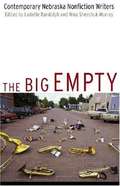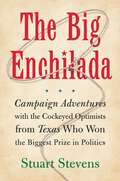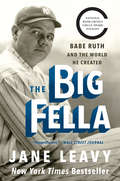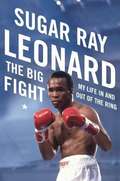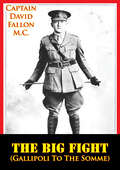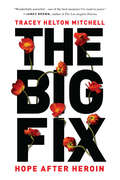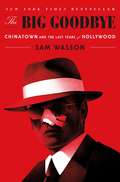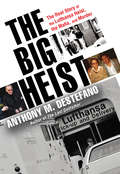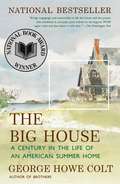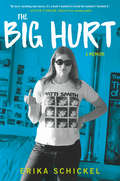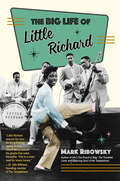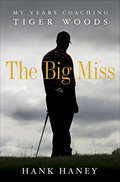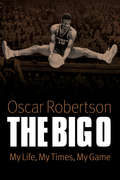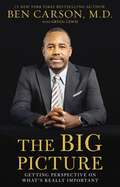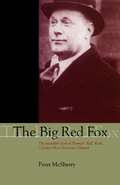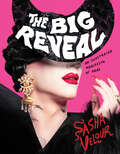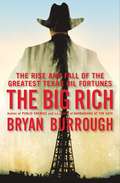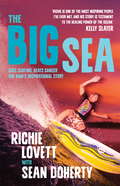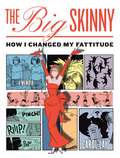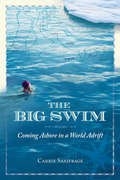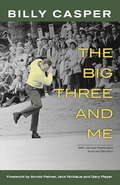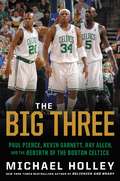- Table View
- List View
The Big Empty: Contemporary Nebraska Nonfiction Writers
by Ladette Randolph Nina Shevchuk-MurrayExploring the State of Nebraska from its rural reaches to its urban engines, from its marvelous ecosystems to its myriad historical and cultural offerings, these narratives evoke Nebraska in all its facets.
The Big Enchilada: Campaign Adventures with the Cockeyed Optimists from Texas Who Won the Biggest Prize in Politics
by Stuart StevensSix years ago he owned a baseball team. Now he's the leader of the free world. The Big Enchilada is a comic anthem to the wild and improbable crusade that propelled George W. Bush into the White House and to the close-knit group of Texans who made it happen, written by "the Bush campaign's Renaissance man" (Time magazine). Writer and political strategist Stuart Stevens has been hailed by Martin Amis as "the perfect companion: brave, funny, and ever-watchful," and The New Yorker has praised him for having "a wonderful eye for the curiosities of human behavior." Here he tells the surprisingly funny, adrenaline-fueled story of the Bush campaign the public never saw -- from the Austin coffee shop where Stevens watched Karl Rove sketch out the Republican master plan on a napkin to the small Methodist church in Crawford, Texas, where the blue-jeaned future president prepared for the make-or-break debates that no one expected him to win. He offers the inside view of the rise and flameout of maverick John McCain; the struggle to come up with a message that could be heard over a booming economy ("Times have never been better. Vote for change," campaign aides joked); and the fierce debates over the upside and downside of "going negative" against a vulnerable adversary. Above all, Stevens turns the familiar political tale of disillusionment on its head. From the moment he arrived in Austin to join the campaign -- "Stevens, get in here and let's bond!" the governor said -- he discovered the peculiar pleasure of working with people who not only respected and admired their candidate but actually liked him. They faced formidable obstacles, from a nation surfing a vast wave of peace and prosperity to an experienced opponent whose seasoned advisers bragged that the campaign would be "a slaughterhouse." But Texans, as Stevens learned, are a confident bunch, and the Bush crowd remained convinced they would win the biggest prize of all -- even on the brink of losing. This is the story of what it was like as only an insider could tell it.
The Big Fella: Babe Ruth and the World He Created
by Jane LeavyFrom Jane Leavy, the award-winning, New York Times bestselling author of The Last Boy and Sandy Koufax, comes the definitive biography of Babe Ruth—the man Roger Angell dubbed "the model for modern celebrity." <p><p>He lived in the present tense—in the camera’s lens. There was no frame he couldn’t or wouldn’t fill. He swung the heaviest bat, earned the most money, and incurred the biggest fines. Like all the new-fangled gadgets then flooding the marketplace—radios, automatic clothes washers, Brownie cameras, microphones and loudspeakers—Babe Ruth "made impossible events happen." <p><p>Aided by his crucial partnership with Christy Walsh—business manager, spin doctor, damage control wizard, and surrogate father, all stuffed into one tightly buttoned double-breasted suit—Ruth drafted the blueprint for modern athletic stardom.His was a life of journeys and itineraries—from uncouth to couth, spartan to spendthrift, abandoned to abandon; from Baltimore to Boston to New York, and back to Boston at the end of his career for a finale with the only team that would have him. There were road trips and hunting trips; grand tours of foreign capitals and post-season promotional tours, not to mention those 714 trips around the bases. <p><p>After hitting his 60th home run in September 1927—a total that would not be exceeded until 1961, when Roger Maris did it with the aid of the extended modern season—he embarked on the mother of all barnstorming tours, a three-week victory lap across America, accompanied by Yankee teammate Lou Gehrig. Walsh called the tour a "Symphony of Swat." The Omaha World Herald called it "the biggest show since Ringling Brothers, Barnum and Bailey, and seven other associated circuses offered their entire performance under one tent." <p><p>In The Big Fella, acclaimed biographer Jane Leavy recreates that 21-day circus and in so doing captures the romp and the pathos that defined Ruth’s life and times. Drawing from more than 250 interviews, a trove of previously untapped documents, and Ruth family records, Leavy breaks through the mythology that has obscured the legend and delivers the man. <P><b>A New York Times Bestseller</b>
The Big Fight
by Michael Leonard Sugar Ray ArkushThe Big Fight is Sugar Ray Leonard's unflinching autobiography, revealing the Olympic hero and world champion in five weight divisions, and the man who struggled with depression, rage, drug addiction and greed. One of six children in a chaotic impoverished family, Ray started boxing as a teenager. His remarkable talent and determination guaranteed his swift rise through the ranks of amateur boxing, culminating in his gold medal win at the 1976 Olympics. In the 1980s his remarkable fights against 'Marvelous' Marvin Hagler, Thomas Hearns and Roberto Duran u known collectively as the 'Four Kings of the Ring' u revolutionised the sport. This legendary series of fights made Leonard the star at the centre of the golden era of modern boxing, and, next to Ali, the biggest ever draw in the sport's history. Leonard tells of the gruelling workouts, the fierce competition, and the notorious corruption he encountered within the sport as he battled to become a champion. With candour and humour he comes to terms with the contradictions that tormented him. Despite his enormous strength, focus and discipline, he was a serial adulterer who suffered bouts of rage and succumbed to alcohol and drug addiction. In examining his victories and failures, Sugar Ray Leonard presents a remarkable portrait of the rise, fall, and ultimate redemption of a true fighter u both inside and outside of the ring.
The Big Fight (Gallipoli To The Somme) [Illustrated Edition]
by Captain David Fallon M.C.Includes the First World War Illustrations Pack - 73 battle plans and diagrams and 198 photos"Gallipoli and the Western Front to the end of 1916, as experienced by the author who served with the Australians and 1/Buckingham Bn of the O&B LIThis book is an account of the author's battlefield experiences at Gallipoli and on the Western Front. Fallon was a pre-war regular (Northumberland Fusiliers) who, when war broke out, was a staff sergeant instructor at the Australian Royal Military College in Duntroon. Transferred in some unexplained fashion to the Australian army he took part in the Gallipoli landings on 25 April 1915, which he describes in gory detail, as he does the rest of the fighting till he was evacuated in December. Back in the British army he was commisioned into the Buckingham Battalion (TF) of the O & B LI (145th Bde/48th Division) with which he fought on the Western Front till badly wounded at the end of 1916. He seems to go out of his way to make his descriptions of the fighting as bloody as possible, and as for the Germans, he has a chapter entitled "Hun Beastliness" in which he makes unbelievable statements such as the two examples which follow: It was the nude body of the Mother Superior. She had been nailed to the door. She had been crucified. In the ruins we brought out the bodies of four nuns, unspeakably mutilated. Their bodies had been stabbed and slashed each more than a hundred times. They had gone to martyrdom resisting incredible brutes. They had fought hard, the blond hair of their assassins clutched in their dead hands. And again, at Wytschaete: Above the wreck of the skyline trench bayonets stuck up, and on them were the severed heads, with horrible smiles under their English caps, of twenty of my men. Referring to German soldiers he writes: They hate the bayonet. The cold steel is not for Hans. Shades of Dad's Army, Lcpl Jones and "They don't like it up 'em"."-Print ed.
The Big Fix: Hope After Heroin
by Tracey Helton MitchellAfter surviving nearly a decade of heroin abuse and hard living on the streets of San Francisco's Tenderloin District, Tracey Helton Mitchell decided to get clean for good. With raw honesty and a poignant perspective on life that only comes from starting at rock bottom, The Big Fix tells her story of transformation from homeless heroin addict to stable mother of three-and the hard work and hard lessons that got her there. Rather than dwelling on the pain of addiction, Tracey focuses on her journey of recovery and rebuilding her life, while exposing the failings of the American rehab system and laying out a path for change. Starting with the first step in her recovery, Tracey re-learns how to interact with men, build new friendships, handle money, and rekindle her relationship with her mother, all while staying sober, sharp, and dedicated to her future. A decidedly female story of addiction, The Big Fix describes the unique challenges faced by women caught in the grip of substance abuse, such as the toxic connection between drug addition and prostitution. Tracey's story of hope, hard work, and rehabilitation will inspire anyone who has been affected by substance abuse while offering hope for a better future.
The Big Freeze: A Reporter's Personal Journey into the World of Egg Freezing and the Quest to Control Our Fertility
by Natalie LampertA fascinating investigation into the lucrative, minimally regulated, fast-growing industry of egg freezing, from a young reporter on a personal journey into the world of cutting-edge reproductive medicine&“An engaging and groundbreaking book.&”—Toni Weschler, MPH, author of Taking Charge of Your FertilityOvaries. Most women have two; journalist Natalie Lampert has only one. Then, in her early twenties, she almost lost it, along with her ability to ever have biological children. Doctors urged her to freeze her eggs, and Lampert started asking questions. The Big Freeze is the story of Lampert&’s personal quest to investigate egg freezing, as well as the multibillion-dollar femtech industry, in order to decide the best way to preserve her own fertility. She attended flashy egg-freezing parties, visited high-priced fertility clinics, talked to dozens of women who froze their eggs, toured the facility in Italy where the technology was developed, and even attended a memorial service for thousands of accidentally destroyed embryos. What was once science fiction is now simply science: Fertility can be frozen in time. Between 2009 and 2022, more than 100,000 women in the United States opted to freeze their eggs. Along with in vitro fertilization, egg freezing is touted as a way for women to &“have it all&” by conquering their biological clocks, in line with the global trend of delaying childbirth. A generation after the Pill, this revolutionary technology offers a new kind of freedom for women. But does egg freezing give women real agency or just the illusion of it?A personal and deeply researched guide to the pros, cons, and many facets of this wildly popular technology, The Big Freeze is a page-turning exploration of the quest to control fertility, with invaluable information that answers the questions women have been afraid to ask—or didn&’t know they should ask in the first place.
The Big Goodbye: Chinatown and the Last Years of Hollywood
by Sam WassonFrom the New York Times bestselling author of Fifth Avenue, Five A.M. and Fosse comes the revelatory account of the making of a modern American masterpiece Chinatown is the Holy Grail of 1970s cinema. Its twist ending is the most notorious in American film and its closing line of dialogue the most haunting. Here for the first time is the incredible true story of its making. In Sam Wasson's telling, it becomes the defining story of the most colorful characters in the most colorful period of Hollywood history. Here is Jack Nicholson at the height of his powers, as compelling a movie star as there has ever been, embarking on his great, doomed love affair with Anjelica Huston. Here is director Roman Polanski, both predator and prey, haunted by the savage death of his wife, returning to Los Angeles, the scene of the crime, where the seeds of his own self-destruction are quickly planted. Here is the fevered dealmaking of "The Kid" Robert Evans, the most consummate of producers. Here too is Robert Towne's fabled script, widely considered the greatest original screenplay ever written. Wasson for the first time peels off layers of myth to provide the true account of its creation. Looming over the story of this classic movie is the imminent eclipse of the '70s filmmaker-friendly studios as they gave way to the corporate Hollywood we know today. In telling that larger story, The Big Goodbye will take its place alongside classics like Easy Riders, Raging Bulls and The Devil's Candy as one of the great movie-world books ever written.Praise for Sam Wasson:"Wasson is a canny chronicler of old Hollywood and its outsize personalities...More than that, he understands that style matters, and, like his subjects, he has a flair for it." - The New Yorker"Sam Wasson is a fabulous social historian because he finds meaning in situations and stories that would otherwise be forgotten if he didn't sleuth them out, lovingly." - Hilton Als
The Big Heist: The Real Story Of The Lufthansa Heist, The Mafia, And Murder
by Anthony M. DeStefano“A comprehensive account of the legendary 1978 heist . . . impressive.” —Publishers Weekly The crime that inspired the movie Goodfellas. The rest of story that couldn’t be told—until now. One of the biggest scores in Mafia history, the Lufthansa Airlines heist of 1978 has become the stuff of Mafia legend—and a decades-long investigation that continues to this day. Pulitzer Prize-winning reporter Anthony DeStefano sheds new light on this legendary unsolved case using recent evidence from the 2015 trial of eighty-year-old mafioso Vincent Asaro, who for the first time speaks out on his role in the fateful Lufthansa heist. This blistering you-are-there account takes you behind the headlines and inside the ranks of America’s infamous Mafia families—with never-before-told stories, late-breaking news, and bombshell revelations: Praise for ANTHONY M. DESTEFANO and His Acclaimed Books “Thrilling American crime writing.” —Jimmy Breslin, author of The Good Rat and winner of the Pulitzer Prize “DeStefano is a master at cutting through the secrecy of the Mafia hierarchy.” —Publishers Weekly “The best and last word on the subject . . . DeStefano brings the story to life.” —Jerry Capeci, creator of GangLandNews.com
The Big Heist: The Real Story of the Lufthansa Heist, the Mafia, and Murder
by Anthony M. Destefano“Terrific DeStefano. He finally gives us a fitting end to the murderous and fabled story of the 1978 Lufthansa heist.”—Nicholas Pileggi, author of Wiseguy and Casino“A comprehensive account of the legendary 1978 heist . . . impressive.” —Publisher’s Weekly The crime that inspired the movie Goodfellas. The story that couldn’t be told—until now. One of the biggest scores in Mafia history, the Lufthansa Airlines heist of 1978 has become the stuff of Mafia legend—and a decades-long investigation that continues to this day. Pulitzer Prize-winning reporter Anthony DeStefano sheds new light on this legendary unsolved case using recent evidence from the 2015 trial of eighty-year-old Mafia don Vincent Asaro, who for the first time speaks out on his role in the fateful Lufthansa heist. This blistering you-are-there account takes you behind the headlines and inside the ranks of America’s infamous crime families—with never-before-told stories, late-breaking news, and bombshell revelations: * New details on the heist’s planning: who was involved, how they pulled it off, and what really happened to the almost $6 million in cash and jewels they stole from JFK Airport * Why suspected heist participant Vincent Asaro was found NOT GUILTY of all charges—racketeering, theft, and murder—even after being observed by the FBI for more than three decades * The shocking discovery of human bones in a Queens home belonging to a relative of Jimmy Burke, the homicidal Lucchese crime family associate who assembled the Lufthansa heist team—and masterminded the caper, then the biggest cash robbery in American history. * The eye-opening testimony of gangsters-turned-informants Salvatore Vitale and Gaspar Valenti—and what it reveals about the Mafia code of silence known as Omerta * The greed, betrayal, murder, and other frightening insights into the Bonanno and Lucchese crime families * Disturbing claims about how some members of the NYPD leaked information to mobster Jimmy Burke and may have helped hide evidence of a mob murder victim's demise An invaluable addition to any crime library, this is the most complete, thorough, and up-to-date account of the Lufthansa heist currently available. Pulitzer-Prize winner Anthony DeStefano draws from his years of experience reporting on the mob for New York Newsday—as well as his firsthand coverage of the Asaro indictment and attendence at the trial—to expose the all-too-human heart of organized crime in America. The Big Heist is thrilling, shocking, and impossible to put down.
The Big House: A Century in the Life of an American Summer Home (An Award-Winning Memoir)
by George Howe ColtFaced with the sale of the century-old family summer house on Cape Cod where he had spent forty-two summers, George Howe Colt recounts returning for one last stay with his wife and children in this stunning memoir that was a National Book Award Finalist and a New York Times Notable Book of the Year.This poignant tribute to the eleven-bedroom jumble of gables, bays, and dormers that watched over weddings, divorces, deaths, anniversaries, birthdays, breakdowns, and love affairs for five generations interweaves Colt&’s final visit with memories of a lifetime of summers. Run-down yet romantic, The Big House stands not only as a cherished reminder of summer&’s ephemeral pleasures but also as a powerful symbol of a vanishing way of life.
The Big Hurt: A Memoir
by Erika SchickelThis complex memoir shows what it was like growing up in the shadow of a literary father and a neglectful mother, getting thrown out of boarding school after being seduced by a teacher, and all of the later-life consequences that ensue.In 1982, Erika Schickel was expelled from her East Coast prep school for sleeping with a teacher. She was that girl—rebellious, precocious, and macking for love. Seduced, caught, and then whisked away in the night to avoid scandal, Schickel&’s provocative, searing, and darkly funny memoir, The Big Hurt, explores the question, How did that girl turn out?Schickel came of age in the 1970s, the progeny of two writers: Richard Schickel, the prominent film critic for TIME magazine, and Julia Whedon, a melancholy mid-list novelist. In the wake of her parents&’ ugly divorce, Erika was packed off to a bohemian boarding school in the Berkshires.The Big Hurt tells two coming-of-age stories: one of a lost girl in a predatory world, and the other of that girl grown up, who in reckoning with her past ends up recreating it with a notorious LA crime novelist, blowing up her marriage and casting herself into the second exile of her life.The Big Hurt looks at a legacy of shame handed down through a maternal bloodline and the cost of epigenetic trauma. It shines a light on the haute culture of 1970s Manhattan that made girls grow up too fast. It looks at the long shadow cast by great, monstrously self-absorbed literary lives and the ways in which women pin themselves like beautiful butterflies to the spreading board of male ego.
The Big Life of Little Richard
by Mark Ribowsky&“This entertaining, fast-paced biography&” of the legendary singer-songwriter &“will thrill fans of Little Richard and early rock and roll&” (Publishers Weekly). Richard Wayne Penniman, known to the world as Little Richard, blazed the trail for generations of musicians: The Beatles, James Brown, the Everly Brothers, Jimi Hendrix, the Rolling Stones, Elton John, Prince . . . the list seems endless. He was &“The Originator,&” &“The Innovator,&” and the self-anointed &“King and Queen of Rock &’n&’ Roll.&” In The Big Life of Little Richard, Mark Ribowsky shares the raucous story of his life from early childhood in Macon, Georgia, to his death in 2020. Ribowsky, acclaimed biographer of musical icons―including the Supremes, the Temptations, Stevie Wonder, and Otis Redding―takes readers through venues, gigs, and studios, conveying the sweaty energy of music sessions limited to a few tracks on an Ampex tape machine and vocals sung along with a live band. He explores Little Richard&’s musicianship; his family life; his uphill battle against racism; his interactions with famous contemporaries and the media; and his lifelong inner conflict between his religion and his sexuality. By 2020, eighty-seven-year-old Little Richard&’s electrifying smile was still intact, as were his bona fides as rock&’s royal architect: the &’50s defined his reign, and he extended elder statesmanship ever since. The Big Life of Little Richard not only explores a legendary stage persona, but also a complex life under the makeup and pomade
The Big Miss: My Years Coaching Tiger Woods
by Hank HaneyThe Big Miss is Hank Haney's candid and surprisingly insightful account of his tumultuous six-year journey with Tiger Woods, during which the supremely gifted golfer collected six major championships and rewrote golf history. Hank was one of the very few people allowed behind the curtain. He was with Tiger 110 days a year, spoke to him over 200 days a year, and stayed at his home up to 30 days a year, observing him in nearly every circumstance: at tournaments, on the practice range, over meals, with his wife, Elin, and relaxing with friends. The relationship between the two men began in March 2004 when Hank received a call from Tiger in which the golf champion asked him to be his coach. It was a call that would change both men's lives. Tiger--only 28 at the time--was by then already an icon, judged by the sporting press as not only one of the best golfers ever, but possibly the best athlete ever. Already he was among the world's highest paid celebrities. There was an air of mystery surrounding him, an aura of invincibility. Unique among athletes, Tiger seemed to be able to shrug off any level of pressure and find a way to win. But Tiger was always looking to improve, and he wanted Hank's help. What Hank soon came to appreciate was that Tiger was one of the most complicated individuals he'd ever met, let alone coached. Although Hank had worked with hundreds of elite golfers and was not easily impressed, there were days watching Tiger on the range when Hank couldn't believe what he was witnessing. On those days, it was impossible to imagine another human playing golf so perfectly. And yet Tiger is human--and Hank's expert eye was adept at spotting where Tiger's perfection ended and an opportunity for improvement existed. Always haunting Tiger was his fear of "the big miss"--the wildly inaccurate golf shot that can ruin an otherwise solid round--and it was because that type of blunder was sometimes part of Tiger's game that Hank carefully redesigned his swing mechanics. Hank's most formidable coaching challenge, though, would be solving the riddle of Tiger's personality. Wary of the emotional distractions that might diminish his game and put him further from his goals, Tiger had developed a variety of tactics to keep people from getting too close, and not even Hank--or Tiger's family and friends, for that matter--was spared "the treatment." Toward the end of Tiger and Hank's time together, the champion's laser-like focus began to blur and he became less willing to put in punishing hours practicing--a disappointment to Hank, who saw in Tiger's behavior signs that his pupil had developed a conflicted relationship with the game. Hints that Tiger hungered to reinvent himself were present in his bizarre infatuation with elite military training, and--in a development Hank didn't see coming--in the scandal that would make headlines in late 2009. It all added up to a big miss that Hank, try as he might, couldn't save Tiger from. There's never been a book about Tiger Woods that is as intimate and revealing--or one so wise about what it takes to coach a superstar athlete.
The Big O: My Life, My Times, My Game
by Oscar P. RobertsonPerhaps the greatest all-around player in basketball history, Oscar Robertson revolutionized basketball as a member of the Cincinnati Royals and won a championship with the Milwaukee Bucks. When he was twenty-three, in 1962, he accomplished one of basketball’s most impressive feats: averaging the triple-double in a single season—a feat never matched since. Cocaptain of the Olympic gold medal team of 1960; named the player of the century by the National Association of Basketball Coaches; named one of the fifty greatest players in NBA history; and inducted into the Basketball Hall of Fame in 1980—Robertson’s accolades are as numerous as they are impressive. But The Big O is also the story of a shy black child from a poor family in a segregated city; of the superstar who, at the height of his career, became the president of the National Basketball Players Association to try to improve conditions for all players. It is the story of the man forced from the game at thirty-four and blacklisted from coaching and broadcasting. But two years after he left basketball, after six years of legal wrangling, Robertson won his lawsuit against the NBA, eliminating the option clause that bound a player to a single NBA team in perpetuity and ending restrictions on free agency. The Big O is the story of how the NBA, as we now know it, was built; of race in America in the second half of the twentieth century; and of an uncompromising man and a complex hero.
The Big Picture: Getting Perspective on What's Really Important in Life
by Ben Carson Gregg LewisIn his grade school days, Ben Carson would hardly have been voted “most likely to become a famous surgeon.” His classmates had already given him another label: class dummy. Then a light clicked on for Ben—and a consuming passion for learning that catapulted him from “zero” test grades to a Yale scholarship, a pioneering role in modern medicine, and an influence that has extended from inner-city schools to corporate boardrooms and Washington corridors of power. What made the difference? Belief in his own potential, a commitment to education and making the most of his opportunities to learn, determination to make the world a better place, and faith in a God who knows no limits. Seeing the Big Picture. In The Big Picture, Ben Carson reveals the spiritual and philosophical foundations that undergird not just his dramatic career, but his approach to all of life. As in his best-selling Gifted Hands Dr. Carson shares colorful behind-the-scenes anecdotes. As in Think Big, he describes his practical principles for success. But The Big Picture is more than an autobiography or a personal-effectiveness manual. Rather, it’s a multifaceted look at the faith and vision that can see us all through hardship and failure, and stir us to bold exploits on behalf of something greater than ourselves. Dr. Carson begins by describing how he cultivated a Big-Picture perspective in his own life. Then he discusses ways to which all of us can approach parenting, family, business and friendships with the Big Picture in mind. Finally he looks at some pressing social issues—in particular, racial diversity, health care, and education—and considers how we ought to view them and what we should do about them in light of the Big Picture. Drawing on a vast array of experiences in roles ranging from trailblazing surgeon to public speaker, to husband and family man, Ben Carson shows how we can turn the course of our lives, out communities, our country, and our world by keeping the Big Picture always in mind.
The Big Red Fox: The Incredible Story of Norman "Red" Ryan, Canada's Most Notorious Criminal
by Peter McsherryShort-listed for the 2000 Arthur Ellis Award for Best Non-Fiction Norman "Red" Ryan was a notorious bank robber, safecracker, and killer. He escaped from Kingston Penitentiary twice - first by force, and then years later by gulling the credulous into believing that he was "reformed." The dupes of Ryan’s second emancipation included the prison’s Roman Catholic chaplain, several nationally prominent citizens, the country’s largest newspaper, and, ultimately, R.B. Bennett, the prime minister of Canada, who made the mistake of arranging a "political parole" for Ryan. Six people - three of them innocent victims - died as a result of Red Ryan’s freedom. Dubbed "the Jesse James of Canada" and "Canada’s most notorious criminal," Ryan had compiled a record of nineteen convictions for crimes of theft and violence, and had been in nine shooting affrays with police and citizens. He was a "lifer" in an era when "life" meant just that. Yet he got out of Kingston after just eleven and a half years and returned to Toronto, the city of his birth, amid fanfare befitting a national hero. His death in a liquor store robbery in Sarnia on May 23, 1936, just ten months after his release, was a huge jolt to Canada, and especially Toronto. How could such an obvious threat to society be paroled from prison as a paragon of reform? This question is central to The Big Red Fox. The answer lies not with Ryan himself - not even the cunning and deceitful Red Ryan could have hoodwinked his way out of a life sentence - but with those who helped him, and who benefited from his release.
The Big Reveal: An Illustrated Manifesto of Drag
by Sasha Velour“Drag embodies the queer possibility that exists within each of us—the infinite ways in which gender, good taste, and art can be lived.” –Sasha VelourThis book is a quilt, piecing together memoir, history, and theory into a living portrait of an artist and an art. Within these pages, illustrated throughout with photos and original artwork, Sasha Velour illuminates drag as a unique form of expression with a rich history and a revolutionary spirit.Each chapter strips off a new layer, removing one tantalizing glove and then another, to reveal all the twists and turns in the life of a queen. As Sasha recalls her own journey, from the women who raised her, to learning the craft of an artist, to success, disaster, and more, she also uncovers the history of queer life around the world that made it all possible.From shamans to “fairies balls,” empresses to RuPaul’s Drag Race (and beyond), The Big Reveal chronicles and celebrates our shared queer pasts. “If we want to be seen as legendary,” writes Sasha, “we have to weave ourselves into history.”From an iconoclastic drag queen comes an equally singular, thought-provoking manifesto that brings necessary and sparkling substance to our understanding of drag, queerness, beauty, and liberation!
The Big Rich: The Rise and Fall of the Greatest Texas Oil Fortunes
by Bryan BurroughIn The Big Rich, bestselling author and Vanity Fair special correspondent Bryan Burrough chronicles the rise and fall of one of the great economic and political powerhouses of the twentieth century: Texas oil. By weaving together the epic sagas of the industry's four greatest fortunes, Burrough has produced an enthralling tale of money, family, and power in the American century. Known in their day as the Big Four, Roy Cullen, H. L. Hunt, Clint Murchison, and Sid Richardson were all from modest backgrounds, and all became patriarchs of the wealthiest oil families in Texas. As a class they came to be known as the Big Rich, and together they created a new legend in America, the swaggering Texas oilman who owns private islands, sprawling ranches and perhaps a football team or two, and mingles with presidents and Hollywood stars. The truth more than lives up to the myth. Along with their peers, the Big Four shifted wealth and power in America away from the East Coast, sending three of their state's native sons to the White House and largely bank rolling the rise of modern conservatism in America. H. L. Hunt became America's richest man by grabbing Texas's largest oilfield out from under the nose of the man who found it; he was also a lifelong bigamist. Clint Murchison entertained British royalty on his Mexican hacienda and bet on racehorses and conducted dirty deals with J. Edgar Hoover. Roy Cullen, an elementary school dropout, used his millions to revive the hapless Texas GOP. And Sid Richardson, the Big Four's fun-loving bachelor, was a friend of several presidents, including, most fatefully, Lyndon Johnson. The Big Four produced offspring who frequently made more headlines, and in some cases more millions, than they did. With few exceptions, however, their fortunes came to an end in a swirl of bitter family feuds, scandals, and bankruptcies, and by the late 1980s, the era of the Big Rich was over. But as Texas native Bryan Burrough reveals in this hugely entertaining account, the profound economic, political, and cultural influence of Texas oil is still keenly felt today. Included are chapter notes, citations, bibliographic notes, and index. Bookshare Note: For the most part written factually, the author's personal bias often shows through, sometimes subtly and other times blatantly.
The Big Sea
by Richie Lovett Sean Doherty'Richie is one of the most inspiring people I've ever met, and his story is testament to the healing power of the ocean.' Kelly SlaterGoes surfing, beats cancer. One man's inspirational story.Richie Lovett might be the world?s unluckiest surfer . . . or its luckiest. We?re not quite sure which.He?s been attacked by a shark, washed into the Indonesian jungle by a tsunami, before finally being diagnosed with cancer. Unlucky? Possibly. One thing we know for sure, Richie Lovett is a survivor; he?s still here today, and what hasn?t killed him has only made him stronger.When doctors told him the cancer in his leg was buried so deep he?d never surf again, Richie ? one of the world?s best surfers ? begged to differ. After radical surgery to rebuild his leg, Rich set about the challenge of learning to surf all over again, discovering plenty about life, and himself, in the process.The Big Sea is one of sport?s most inspiring stories. But you don?t have to be a surfer or a sportsperson to know what it feels like to confront challenges. This is vital reading for anyone who?s had to face adversity or felt like they were about to be wiped out.Engagingly honest, Richie Lovett shows us that attitude is everything.
The Big Sea: An Autobiography (American Century)
by Langston HughesIntroduction by Arnold Rampersad.Langston Hughes, born in 1902, came of age early in the 1920s. In The Big Sea he recounts those memorable years in the two great playgrounds of the decade--Harlem and Paris. In Paris he was a cook and waiter in nightclubs. He knew the musicians and dancers, the drunks and dope fiends. In Harlem he was a rising young poet--at the center of the "Harlem Renaissance."Arnold Rampersad writes in his incisive new introduction to The Big Sea, an American classic: "This is American writing at its best--simpler than Hemingway; as simple and direct as that of another Missouri-born writer...Mark Twain."
The Big Skinny: How I Changed My Fattitude
by Carol LayHere’s the skinny: After a lifetime of yo-yo dieting with pills, hypnosis, and ill-informed half-measures, Carol Lay finally shed her excess pounds and kept them off. Now this California cartoonist shares her experiences in a funny, genuine, and eye-popping graphic memoir that tells Carol’s story and shows you how you can do it, too.
The Big Swim: Coming Ashore in a World Adrift
by Carrie SaxifrageHow the climate crisis changed one woman's life: &“Stunningly beautiful . . . I found myself laughing out loud on one page and brushing away tears on the next.&” —Ruth Ozeki, author of A Tale for the Time Being Climate change is alarming and complicated. Governments are acting too slowly or not at all, and not enough people feel informed or empowered enough to demand action. But ignoring a catastrophe of such magnitude is a certain path to disaster.The Big Swim puts forward the idea that personal growth arises from facing both inner tensions and threats to the biosphere. In a collection of stories that is frequently touching, surprisingly funny, and always thought-provoking, Carrie Saxifrage seeks out the places where science meets self-discovery, inviting us to join her as she: Learns the art of appreciation from an ancient jawboneHikes solo through the wilderness to find balance in a field of blueberriesSwims for four hours through cold, open water, seeking a fleeting state of grace Each of the stories in The Big Swim encourages possibilities for greater personal satisfaction with lower environmental impacts. While exploring significant topics, such as sustainable forestry, nature-centered philosophy, or First Nations&’ culture, the author discovers that the greatest adventure is learning to align how she lives with what she loves. By turning her own despair into action, she paves the way for us all to discover the many tools we have at hand to meet the biggest challenge humanity has ever faced.
The Big Three and Me
by Billy CasperBilly Casper had a higher winning percentage than Arnold Palmer, he won twice as many times on the PGA Tour as Gary Player, and during his career he finished in the top twenty-five more consistently than Jack Nicklaus. And yet, when golf historians write about the legends of the game, with special attention paid to the above-listed "Big Three," his name is often left out of the discussion, or is at best an afterthought.In this fascinating autobiography, Casper tells his life story, shining candid insight into the man who quietly collected fifty-one PGA Tour victories, the seventh highest total in history.
The Big Three: Paul Pierce, Kevin Garnett, Ray Allen, and the Rebirth of the Boston Celtics
by Michael HolleyNew York Times bestselling sportswriter Michael Holley tells the inside story of how Paul Pierce, Ray Allen, and Kevin Garnett joined together to form the most dominant team in basketball and lead the Boston Celtics to their first championship in more than two decades.The first of "The Big Three" was Paul Pierce. As Boston Celtics fans watched the team retire Pierce's jersey in a ceremony on February 11, 2018, they remembered again the incredible performances Pierce put on in the city for fifteen years, helping the Celtics escape the bottom of their conference to become champions and perennial championship contenders. But Pierce's time in the city wasn't always so smooth. In 2000, he was stabbed in a downtown nightclub eleven times in a seemingly random attack. Six years later, remaining the sole star on a struggling team, he asked to be traded and briefly became a lightning rod among fans.Then, in 2007, the Boston Celtics General Manager made two monumental trades, bringing Ray Allen and Kevin Garnett to Boston. A press conference on July 31, 2007 was a sight to behold: Pierce, KG, and Ray Allen holding up Celtics jerseys for the flood of media. Coach Doc Rivers made sure the team bonded over the thought of winning a title and living by a Bantu term called Ubuntu, which translates as "I am because we are." Rivers wanted to make it clear that togetherness and brotherhood would help them maximize their talent and win. What came next -- the synthesis of the Celtics' "Big Three" and their dominant championship run -- cemented their standing as one of great teams in NBA history, a rival to Kobe Bryant's Lakers and LeBron James's Cavaliers.This is the team that brought excitement back to the Garden, and therefore to one of the most storied franchises in all of sports. They met their historic rivals, the Lakers, in the 2008 NBA Finals, winning the series in Game 6, in a rout on their home court with a raucous, concert like atmosphere. Along the victory parade route, Paul Pierce smoked a cigar -- as a tribute to legendary former Celtics Coach Red Auerbach. In a city now defined by a wealth of championships, "The Big Three" joined the club. Michael Holley, the premier chronicler of Boston sports, brings their story to life with countless untold stories and behind-the-scenes details in another bestselling tome for New England and sports fans across the country.
